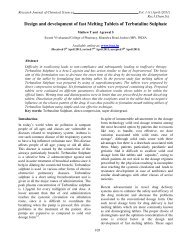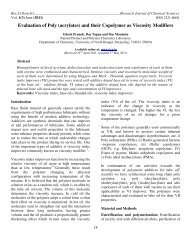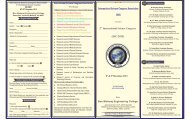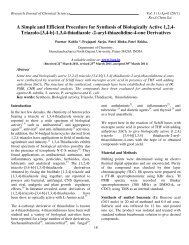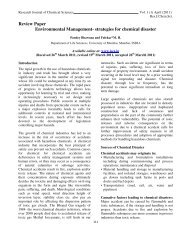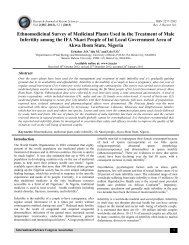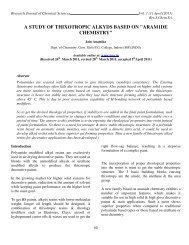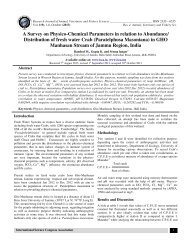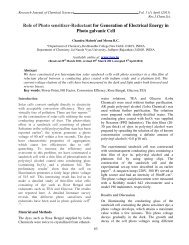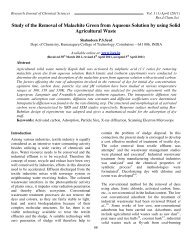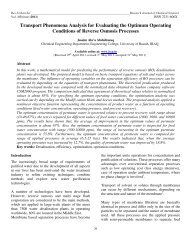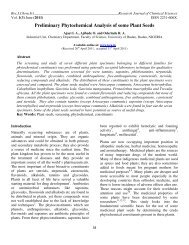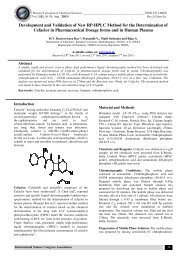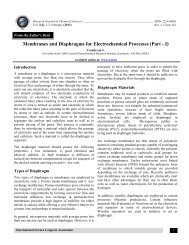An Overview of Badranjboya (Melissa officinalis) - ISCA
An Overview of Badranjboya (Melissa officinalis) - ISCA
An Overview of Badranjboya (Melissa officinalis) - ISCA
Create successful ePaper yourself
Turn your PDF publications into a flip-book with our unique Google optimized e-Paper software.
International Research Journal <strong>of</strong> Biological Sciences ___________________________________ ISSN 2278-3202<br />
Vol. 2(12), 107-109, December (2013)<br />
Int. Res. J. Biological Sci.<br />
Mini Review Paper<br />
<strong>An</strong> <strong>Overview</strong> <strong>of</strong> <strong>Badranjboya</strong> (<strong>Melissa</strong> <strong>of</strong>ficinalis)<br />
Abstract<br />
Sadiya Noorul Basar * and Roohi Zaman<br />
Dept. <strong>of</strong> Ilmul Saidla, National Institute <strong>of</strong> Unani Medicine, Bangalore, Karnataka, INDIA<br />
Available online at: www.isca.in, www.isca.me<br />
Received 22 nd July 2013, revised 25 th August 2013, accepted 9 th October 2013<br />
<strong>Melissa</strong> <strong>of</strong>ficinalis L., is a is a perennial plant, which belongs to the family labiatae .It is basically cultivated in<br />
Mediterranean region and native to Europe, Northern Africa and West asia. It is called lemon balm, bee balm, melissa,<br />
sweet balm . It has a lemony flavor and fragrance. Traditionally this herb was used for longevity, healing wound, relaxing<br />
the heart, treating tooth ache, Nowadays it is used in anxiety, mild depression, restlessness, irritability, indigestion, acidity,<br />
nausea, bloating and colicky pains, and cold sores. It is also called as a hormonal herb due to its antithyroid activity.<br />
Keywords: <strong>Melissa</strong> <strong>of</strong>ficinalis, <strong>Badranjboya</strong>, lemon balm, depression, antithyroid activity.<br />
Introduction<br />
<strong>Melissa</strong> is also called as bee balm because the word <strong>Melissa</strong><br />
comes from a greek word which means bee and as melissa has<br />
great attraction towards bee hence it is called so 1 . It is called as<br />
Badrangboya 2 , taragarbha in Persian, Mufarrehal qhalb 2,3<br />
Utrajul Raihath 4 , Warqe habaqe Rauhawi 5 in Arabic, Billi<br />
lotan 2,3,4 in Hindi, Mountain balm, sweet balm or Lemon balm<br />
in Engish 6 . Lemon balm is a medicinal plant as well as most<br />
important commercial plants during the recent decades 7 . It is<br />
used in traditional medicine for various ailments like a plant<br />
juice, cream or tea infusion is used for nervous agitation, and for<br />
promoting sleep, and ameliorates functional gastrointestinal<br />
complaints, hysteria,melancholia, chronic bronchial catarrh,<br />
migraine, toothache, earache, headache and high blood pressure<br />
and, externally, for rheumatism, nerve pains and stiff necks<br />
(compress) 8 . In Unani sysyem <strong>of</strong> medicine its grass and seeds<br />
are used in it is used in epilepsy, paralysis, bells palsi, arthritis,<br />
Mastitis, halitosis, its syrup and distillate are made for different<br />
ailments 9 .<br />
Origin and Distribution<br />
<strong>Melissa</strong> is a native <strong>of</strong> southern Europe, Western Asia, Northern<br />
Africa, east as far as the Caucasus and northern <strong>of</strong> Iran but now<br />
it grows throught the world, In India it is found in temperate<br />
Himalaya from Garhwal to Sikkim and Khassia mountains 7 .<br />
Lemon balm in India is found to grow on sandy, scrubby area,<br />
damp wasteland, at elevations ranging from sea level to the<br />
mountains. It has been used traditionally for different medicinal<br />
purposes but nowadays for several applications in pharmacy,<br />
nutritional and sanitary industrials, lemon balm is being used<br />
enormously 10 .<br />
Botanical Description<br />
Macroscopic: The leaves are broadly ovate,or ovatelanceolate,crenate.<br />
The petiole varies in length from 1-1.2 cm<br />
while lamina is about 2.5x1-3.5x1.2 cm.<br />
Microscopic: In transverse section the leaf shows single layered<br />
upper and lower epidermis provided with glandular and non<br />
glandular hairs. The glandular hairs are characterized by the<br />
presence <strong>of</strong> unicellular circular head and uni to multi celled tail.<br />
The non glandular hairs are unbranched, uniserate, multicellular,<br />
with the outermost cells tapering. These are<br />
ornamented with small bristles. Upper epidermal cells are<br />
mostly larger than the lower ones , while both are covered with<br />
cuticle. The epidermis is followed by single layer <strong>of</strong> palisade<br />
tissue continuos to lamina whereas it discontinues at the veins or<br />
midrib which is replaced by 3 to 4 layered collenchymatous<br />
tissue on the upper side and 3-6 layered on the lower side <strong>of</strong> the<br />
leaf. The collenchymas is followed by circular parenchyma<br />
tissues with large intercellular spaces. The vascular bundle is<br />
kidney shaped and is collateral. The vessel members are mostly<br />
with spiral to reticulate thickenings with simple perforations<br />
plates and tracheids are mostly pitted. The stomata are<br />
indistinct 5 .<br />
Unani Description <strong>of</strong> <strong>Melissa</strong> <strong>of</strong>ficinalis<br />
<strong>Badranjboya</strong> is a grass fragrant, greenish black and bitter in<br />
nature. It is called as billi lotan because the cat loves to play on<br />
it. It is <strong>of</strong> 2 types: i. Shorter species whose leaves are short and<br />
light and thin, and its edges are protruded and it has many bands<br />
as teeth <strong>of</strong> the saw, its flowers are bluish red in colour and many<br />
times it is cooked as a vegetable. It usually blooms in mausam e<br />
rabeeh, its root do not branch. Its seeds resemble seeds <strong>of</strong> alsi,<br />
but are smaller than that and colour is brownish this type is<br />
called as utrajiya and turanjan, ii. Bigger species, fragrance is<br />
same as that <strong>of</strong> smaller species but much stronger and its leaves<br />
are not long but round, colour is greenish on rubbing it gives<br />
smell <strong>of</strong> lemon and leaves resemble like that <strong>of</strong> jangli tulsi.<br />
Some scholars have stated that its leaves are rough, broad and<br />
appear same as that <strong>of</strong> nana (pudina). Its root gives many<br />
branches and flowers are white in colour and according to some<br />
colour is bluish white and seeds are very less. its seeds are equal<br />
International Science Congress Association 107
International Research Journal <strong>of</strong> Biological Sciences ________________________________________________ ISSN 2278-3202<br />
Vol. 2(12), 107-109, December (2013)<br />
Int. Res. J. Biological Sci.<br />
to that <strong>of</strong> isapghoal, its colour is blackish and has fragrance it is<br />
usually found in damp areas its potency is same as that <strong>of</strong><br />
farasiyoon and is said that it is a type <strong>of</strong> raihan 2-4 .<br />
Taxonomical Classification: Kingdom: Plantae, Division:<br />
Tracheophyta, Subdivision: Speramtophyta, Class:<br />
Magnoliopsida, Superorder: Asteranae, Order: lamiales, Family:<br />
Lamiaceae, Genus:<strong>Melissa</strong>, Species:<strong>Melissa</strong> <strong>of</strong>ficinalis L.<br />
Phytochemical Studies<br />
The leaf <strong>of</strong> <strong>Melissa</strong> <strong>of</strong>ficnalis contains monoterpenoid aldehyde,<br />
flavonoids (quercitrin, rhamnocitrin), polyphenolic compounds<br />
(rosmarinic acid, caffeic acid and protocatechuic acid),<br />
triterpenes (ursolic and oleanolic acids), monotherpenoid<br />
aldehides, sesquiterpenes, tannins and monoterpene<br />
glycosides 11 , essencial oils (citral) and flavonoids (luteolin) 12 .<br />
A study on <strong>Melissa</strong> <strong>of</strong>ficinalis L. (lemon balm) leaf extract has<br />
shown to contain more than 5% hydroxycinnamic acid content<br />
is known to have anti axiety effects 13 .<br />
Pharmacological Activities<br />
<strong>An</strong>tiviral activity: In one <strong>of</strong> the study 10% aqueous extracts <strong>of</strong><br />
<strong>Melissa</strong> inhibited the replication in vitro <strong>of</strong> herpes simplex virus<br />
type 2, influenza virus A2 (Mannheim 57), influenza viruses<br />
and myxoviruses in vitro and vaccinia virus 14-16 . In a study<br />
where tannin isolated from aqueous extract <strong>of</strong> the <strong>Melissa</strong><br />
leaves inhibited haemagglutination induced by Newcastle<br />
disease virus or mumps virus 14,17 , tanninfree<br />
polyphenol fraction <strong>of</strong> an aqueous extract inhibited herpes<br />
simplex and vaccinia viruses in egg and cell culture systems 14,18<br />
aqueous extracts <strong>of</strong> the leaves have also been reported to have<br />
activity against Semliki Forest virus 14,19 .<br />
<strong>An</strong>tispasmodic activity: <strong>An</strong> ethanol extract <strong>of</strong> the leaves and<br />
essential oil inhibited histamine- and barium-induced<br />
contractions <strong>of</strong> guinea-pig ileum in vitro which in turn inhibited<br />
the contractions guinea-pig ileum which exhibited smooth<br />
muscle relaxant activity in tracheal muscle while an aqueous<br />
extract was inactive. A 30% ethanol extract did not inhibit<br />
acetylcholine- and histamine-induced contractions in guinea-pig<br />
ileum in vitro at concentrations up to 10ml/ml 14,20,21 .<br />
Psychoneurological activity: <strong>An</strong> acute treatment with <strong>Melissa</strong><br />
<strong>of</strong>ficinalis L.had shown to improve cognitive performance and<br />
mood, reduces induced stress and anxiolytic effects in<br />
humans 22-24 .<br />
Gastrointestinal Tract: Traditionally <strong>Melissa</strong> has been used<br />
for GIT disorders, to promote digestion and for griping pains <strong>of</strong><br />
the belly. According to the German commission E<br />
monograph <strong>Melissa</strong> is indicated in functional gastrointestinal<br />
complaints especially for spasm in the digestive tract and<br />
flatulent dyspepsia and carminative properties 25 .<br />
<strong>An</strong>tioxidant Property: <strong>Melissa</strong> essential oil has been shown to<br />
have antioxidant properties which is due to the presence <strong>of</strong><br />
mono and sesquiterpenes components, caffeic acid and<br />
flavonoids. A study on mice <strong>Melissa</strong> containing rosmarinic acid<br />
had an activity to protect the liver from damage with its<br />
antioxidant action. These studies indicate that <strong>Melissa</strong> has a<br />
strong antioxidant property 26 .<br />
Some recent studies on <strong>Melissa</strong> has shown that, it is useful in<br />
treating hyperthyroidism and Graves’ disease. Firstly, In a dose<br />
dependant freeze dried extract <strong>of</strong> <strong>Melissa</strong> has inhibited the<br />
binding <strong>of</strong> Graves’ disease immunoglobulins to the thyroid.<br />
These studies suggest that <strong>Melissa</strong> is potentially useful in<br />
treating Graves’ disease and hyperthyroidism 27 .<br />
Pharmacological Uses according to Unani Medicine:<br />
Mufarreh Qhalb, Muqhawwi e qhalb, Munzij e sauda, Musaffi e<br />
khoon, Mutayyab e Nikhath, Muhallil 2,3,4 , However <strong>Melissa</strong> is<br />
known to cause some <strong>of</strong> the side effects like headache, burning<br />
micturation and problematic to hot temperament people as the<br />
temperament <strong>of</strong> <strong>Melissa</strong> is Hot and dry in 2 nd degree.<br />
Conclusion<br />
<strong>Melissa</strong> <strong>of</strong>ficinalis L.which is called as lemon balm, bee balm,<br />
melissa, sweet balm has enormous health advantages as<br />
mentioned in traditional advantages when these were analysed<br />
were proven to be scientific. A lot more number <strong>of</strong> upcoming<br />
researches are being done which would be much more worthful.<br />
References<br />
1. Chevallier A., Encyclopedia <strong>of</strong> medicinal plants, 6 th edt.<br />
New York. United states <strong>of</strong> America (1996)<br />
2. Hakeem M., Bustanul Mufradat, New Delhi: Idara Kitabul<br />
Shifa, 110, (2002)<br />
3. Ghani N., Khazainul Advia. New Delhi: Idara Kitabul<br />
Shifa, 149, 390 (2011)<br />
4. Kabeeruddin H.M., Ilmul Adviae Nafeesi, Delhi: Aijaz<br />
Publishing house, 90, (2007)<br />
5. <strong>An</strong>onymous, Unani Pharmacopoeia <strong>of</strong> India, Part 1, Vol 2.<br />
New Delhi: Dept. <strong>of</strong> AYUSH, MOHFW, Govt. <strong>of</strong> India, 19,<br />
(2007)<br />
6. Khare C.P, Indian medicinal plants - <strong>An</strong> Illustrated<br />
Dictionary, New York: Springer science and Business<br />
media, (2007)<br />
7. Aharizad S., Study <strong>of</strong> genetic diversity in lemon balm<br />
(<strong>Melissa</strong> <strong>of</strong>ficinalis l.) populations based on morphological<br />
traits and essential oils content, Scholars Research Library<br />
<strong>An</strong>nals <strong>of</strong> Biological Research, 3(12), 5748-5753 (2012)<br />
8. Herodez S.S., Solvent extraction study <strong>of</strong> antioxidants from<br />
Balm (<strong>Melissa</strong> <strong>of</strong>ficinalis L.) leaves, <strong>An</strong>alytical, Nutritional<br />
and Clinical Methods, Food Chemistry, 80, 275–282 (2003)<br />
International Science Congress Association 108
International Research Journal <strong>of</strong> Biological Sciences ________________________________________________ ISSN 2278-3202<br />
Vol. 2(12), 107-109, December (2013)<br />
Int. Res. J. Biological Sci.<br />
9. Kabeeruddin H.M., Maghzanul Mufarradat Almaro<strong>of</strong><br />
Khawasul Advia. 2 nd edt. Delhi: Aijaz Publishing house,<br />
112 (2000)<br />
10. Sari A.O., Yield Characteristics and Essential Oil<br />
Composition <strong>of</strong> Lemon Balm (<strong>Melissa</strong> <strong>of</strong>ficinalis L.)<br />
Grown in the Aegean Region <strong>of</strong> Turkey, Turk. J. Agric.<br />
For., 26, 217-224 (2002)<br />
11. Emamghoreishi M., <strong>An</strong>tidepressant effect <strong>of</strong> <strong>Melissa</strong><br />
<strong>of</strong>ficinalis in the forced swimming test, DARU, 17(1),<br />
(2009)<br />
12. Guginski G., Luiz A.P., Silva M.S., Massaro M., Martins<br />
D.F., Chaves J., Mattos R.W., Silveira D., Ferreira V.M.M.<br />
and Calixto J.B. et al., Mechanisms involved in the<br />
antinociception caused by ethanolic extract obtained from<br />
the leaves <strong>of</strong> <strong>Melissa</strong> <strong>of</strong>ficinalis (lemon balm) in mice,<br />
Pharmacol Biochem Behav, 93, 10-16 (2009)<br />
13. Cases J., Pilot trial <strong>of</strong> <strong>Melissa</strong> <strong>of</strong>ficinalis L. leaf extract in<br />
the treatment <strong>of</strong> volunteers suffering from mild-to-moderate<br />
anxiety disorders and sleep disturbances, Med J Nutrition<br />
Metab., 4(3), 211–218 (2011)<br />
14. Parameswari G. et.al., Note on Pharmacological Activities<br />
<strong>of</strong> <strong>Melissa</strong> <strong>of</strong>ficinalis L., Ethnobotanical Leaflets 13, 211-<br />
12 (2009)<br />
15. Wolbling R.H. and Leonhardt K., Local therapy <strong>of</strong> herpes<br />
simplex with dried extract from <strong>Melissa</strong> <strong>of</strong>ficinalis,<br />
Phytomedicine, 1, 25–31 (1994)<br />
16. May G. and Willuhn G., <strong>An</strong>tiviral activity <strong>of</strong> aqueous<br />
extracts from medicinal plants in tissue<br />
cultures, Arzneimittel-Forschung, 28, 1–7 (1978)<br />
17. Kucera L.S. and Herrmann E.C., <strong>An</strong>tiviral substances in<br />
plants <strong>of</strong> the mint family (Labiatae), II. Tannin<br />
<strong>of</strong> <strong>Melissa</strong> <strong>of</strong>ficinalis, Proceedings <strong>of</strong> the Society<br />
<strong>of</strong> Experimental Biology and Medicine, 124, 865–869<br />
(1967)<br />
18. Herrmann E.C. and Kucera L.S., <strong>An</strong>tiviral substances in<br />
plants <strong>of</strong> the mint family (Labiatae),<br />
II. Nontannin polyphenol <strong>of</strong> <strong>Melissa</strong> <strong>of</strong>ficinalis,<br />
Proceedings <strong>of</strong> the Society <strong>of</strong> Experimental Biology and<br />
Medicine, 124, 869–874 (1967)<br />
19. Van den Berghe D.A., Present status and prospects <strong>of</strong> plant<br />
products as antiviral agents, In: Vlietinck A.J., Dommisse<br />
R.A., eds. Advances in medicinal plant research. Stuttgart,<br />
Wissenschaftliche Verlagsgesellschaft, 47–99 (1985)<br />
20. Forster H.B., Niklas H. and Lutz S., <strong>An</strong>tispasmodic effects<br />
<strong>of</strong> some medicinal plants, Planta Medica, 40, 309–312<br />
(1980)<br />
21. Reiter M. and Brandt W., Relaxant effects on tracheal<br />
and ileal smooth muscles <strong>of</strong> the guinea-pig, Arzneimittel-<br />
Forschung, 35, 408–414 (1985)<br />
22. Kennedy D.O., Little W., Haskell C.F. and Scholey A.B.,<br />
<strong>An</strong>xiolytic effects <strong>of</strong> a combination <strong>of</strong> <strong>Melissa</strong><br />
<strong>of</strong>ficinalis and Valeriana <strong>of</strong>ficinalis during laboratory<br />
induced stress, Phytother Res., 20, 96–102 (2006)<br />
23. Ibarra A., Feuillere N., Roller M., Lesburgere E. and<br />
Beracochea D., Effects <strong>of</strong> chronic administration <strong>of</strong><strong>Melissa</strong><br />
<strong>of</strong>ficinalis L. extract on anxiety-like reactivity and on<br />
circadian and exploratory activities in mice, Phytomedicine,<br />
17, 397–403 (2010)<br />
24. Awad R., Muhammad A., Durst T., Trudeau V.L. and<br />
Arnason J.T., Bioassay-guided fractionation <strong>of</strong> lemon balm<br />
(<strong>Melissa</strong> <strong>of</strong>ficinalis L.) using an in vitro measure <strong>of</strong> GABA<br />
transaminaseactivity, PhytotherRes., 23, 1075–1081 (2009)<br />
25. Pawson J., A literature review <strong>of</strong> the medicinal properties<br />
<strong>of</strong> lemonbalm, Herbal remedies for herbalism, forgeing and<br />
nature, herbalremediesfor.co.uk, 119(12), 1005-1012<br />
(2006)<br />
26. Koksal E., <strong>An</strong>tioxidant activity <strong>of</strong> <strong>Melissa</strong> <strong>of</strong>ficinalis<br />
leaves, Journal <strong>of</strong> Medicinal Plants Research,5(2): 217-222<br />
http://www.academicjournals.org/JMPR (2011)<br />
International Science Congress Association 109



